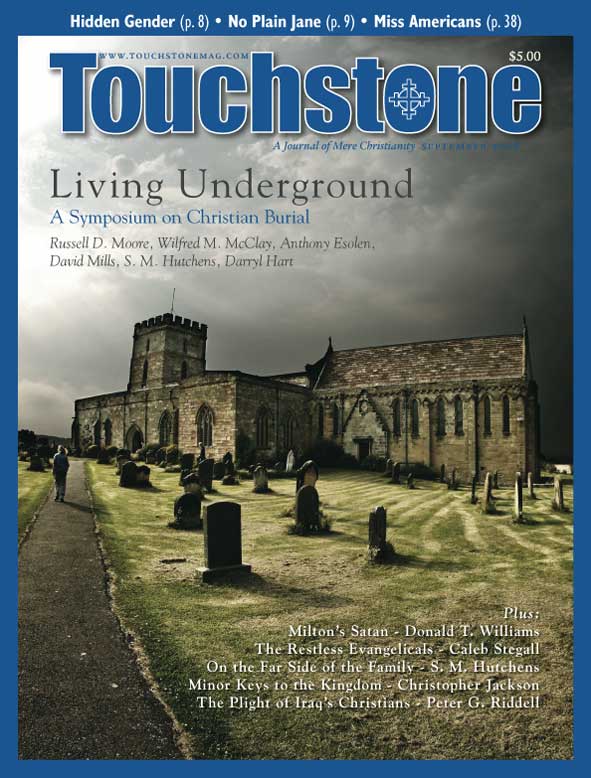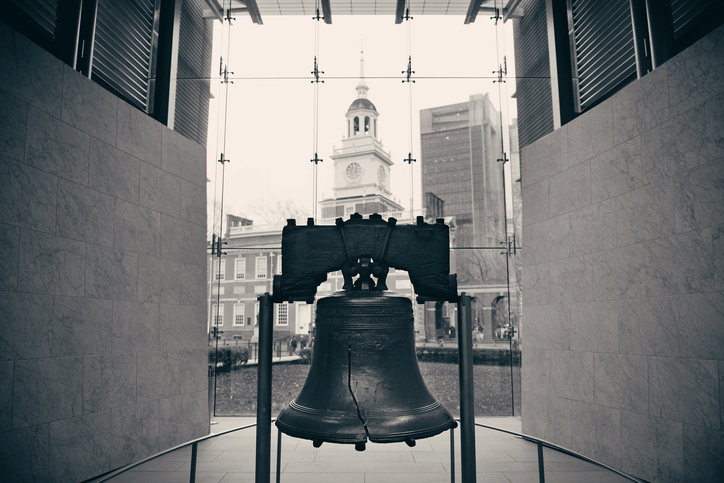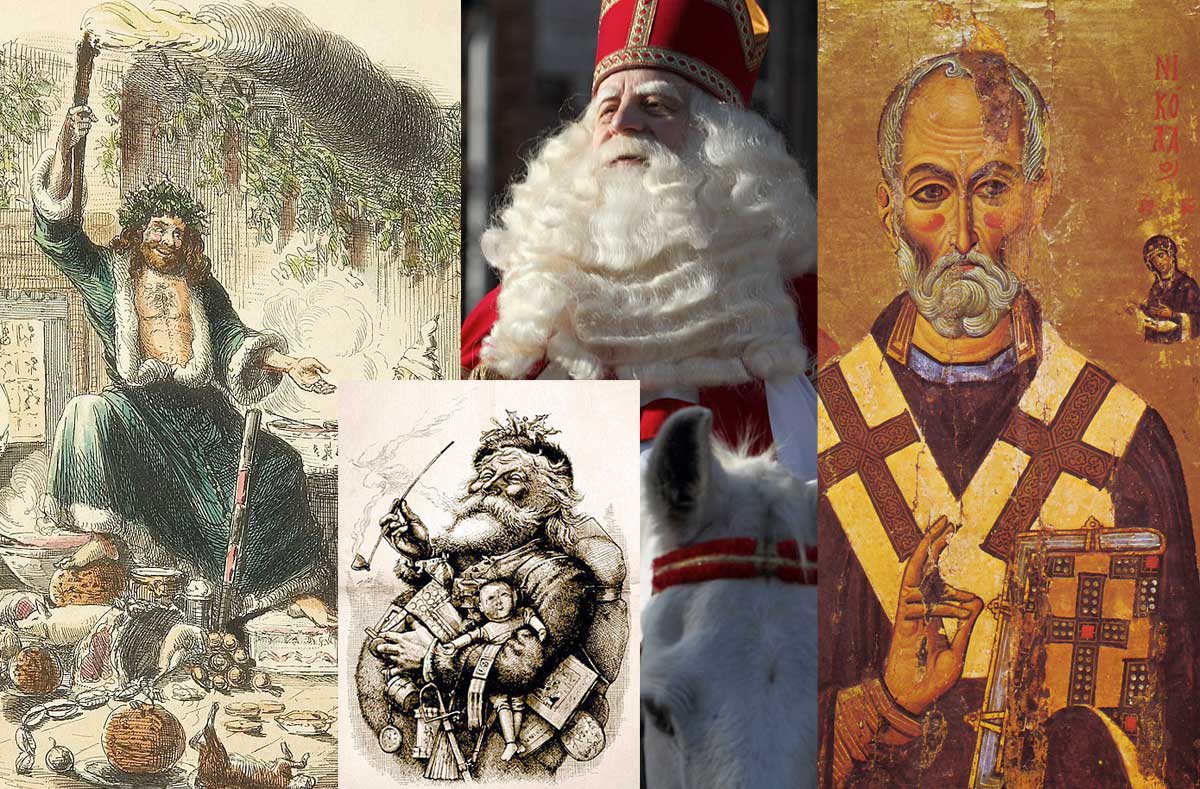View
No Plain Jane
Eleanor Bourg Donlon on Hollywood’s Disgrace & Jane Austen’s Wisdom
Finally! The teenage passion of Jane Austen will become known to the world! Chemistry! Passion! Rebellious self-determination! With the movie Becoming Jane, devoted fans will become ever more devoted! The Regency period and the twenty-first century will embrace!
And this 25-year-old disciple of Miss Austen feels suddenly very old and tired.
Comprehensive Misinterpretations
Becoming Jane purports to tell the story of how the young woman became the author. To the distress of her parents, young Jane is unmarried and has ambitions as a writer. Although her initial dislike of Tom Lefroy changes to mutual and passionate love, the young man’s uncle, upon whom he is financially dependent, forbids the match.
The plot winds through a tumult of emotions, with arguments, separations, new engagements for both hero and heroine, and a final separation when Austen relinquishes her lover out of consideration for his family. This experience inspires her to write Pride and Prejudice. The movie ends with a meeting between Austen and Lefroy many years later—laughably improbable and embarrassingly sentimental.
There is very little evidence to support this over-romanticized tale. Tom Lefroy did exist, there was a brief flirtation between him and Austen, they did not marry, and she did write Pride and Prejudice. Beyond this, there is nothing to suggest the extraordinary historical liberties taken by the filmmakers.
Becoming Jane could be taken as an innocent fiction, but why was such a film made in the first place? The answer is that it is the latest in a long line of comprehensive misinterpretations of Austen classics established upon the premise that unless Jane Austen experienced adolescent passion and rebelled against traditional authorities, she was not a “real” woman.
Her life, letters, early writing, and general demeanor demonstrate a maturity and poise completely foreign to our expectation of a “teenager.” That’s the real problem. We have invented a false category of person—the “teenager”—who has the rights and “needs” of an adult but is not expected to behave as an adult, and who is expected to make all sorts of embarrassing and sometimes harmful mistakes.
In Austen’s day, children (who appear very infrequently in the novels and are almost never heard) were expected to mature into adulthood. Those who didn’t accomplish the transition smoothly were awkward, raucous, socially disruptive, or degenerate (see Lydia Bennet or any of the Austen villains).
Nearly every female undergraduate of my acquaintance will name Pride and Prejudice as her favorite novel, usually adding that she adores Colin Firth, who played Mr. Darcy in the 1995 movie. They want to be Elizabeth Bennet and to marry Mr. Darcy. What they don’t realize is that, by Regency standards, they are so many Lydias and Mr. Darcy wouldn’t look at them twice.
So Many Lydias
Unrestrained and full of “high animal spirits,” the moral weakness of Lydia Bennet is the negative catalyst that drives the action of Pride and Prejudice, as Elizabeth herself laments:
Our importance, our respectability in the world must be affected by the wild volatility, the assurance and disdain of all restraint which mark Lydia’s character. . . . Vain, ignorant, idle, and absolutely uncontrolled! Oh! my dear father, can you suppose it possible that they will not be censured and despised wherever they are known, and that their sisters will not be often involved in the disgrace?
Does today’s young woman bother about the danger of disgrace? How restrained or prudent are our young women? We have but to look at the typical university crowd to find the answer. For these women, prudence means prudery and virtue means repression. All they know is cheap sex—impersonal, and destructive to the soul. Austen shows a radically different understanding of femininity.
Yet the majority of Austen movies turn her heroines into Lydias, but Lydias with a Regency style. The common practice is to excise the morality from the stories entirely. As a consequence, the tragic lack of understanding described above is encouraged by filmmakers—for whom the cleverly wrought plots, enchanting romance, memorable characters, and exquisite period costumes of the Austen enterprise are golden.
The novels are “grunged up” and modernized in an effort to justify the moral and social immaturity of the viewer. As a consequence, Austen movies have been pigeonholed into the “chick flick” genre, alienating most male viewers (unless they are dragged to the theater by their wives and girlfriends), and reducing her sophisticated, virtue-based world to Hollywood romance.
Such is the problem with the Keira Knightley showcase Pride and Prejudice (2005)—that is, aside from the bizarre sets (colonial America, perhaps?), the mismanagement of social classes (the Bennets were financially constrained gentility, not uncouth and filthy farmers), unique character interpretations (no one but Donald Sutherland could have presented a Mr. Bennet who drools), and the ceaseless shots of Knightley’s vacant facial expressions.
The filmmakers seem to think modern audiences are too dense to pick up on the nuances of romance—in a word, a glance, or a modest but heroic action—but need innumerable bedroom scenes and voluminous nighties. Character, friendship, and witty dialogue are not enough; sexual arousal must be mimed at every step or there is no sense of erotic tension.
Similarly, the latest foray of Andrew Davies (a screenwriter and self-proclaimed expert on period drama) into the Austen world brings drabness and disturbing undercurrents to Sense and Sensibility (2007) (particularly jarring when compared to the decorous 1995 Ang Lee/Emma Thompson collaboration). Marianne is presented as a modern young woman, full of independent thought and sincere feeling; thus, her unconventional romping and self-absorbed moping are not reproached. Elinor, who refuses to condemn even the most imprudent behavior, becomes very dull indeed.
At the same time, Davies actively “sexes up” the novel in a prolonged soft-core porn scene showing the seduction of Colonel Brandon’s ward by a wall-eyed Mr. Willoughby, and in scene upon scene of tempestuous waves crashing onto rocky shores (the universal placeholder for the unspoken intensity of passion).
As a final insult to the novel, a predatory Colonel Brandon trains hawks and is far too eager to strip a sopping-wet Marianne. The story no longer makes sense. It is not only unfaithful to Austen’s novel, it does not even entertain.
The Forgotten Lesson
In a particular way, the clash of moral outlooks results in filmmakers’ complete incomprehension of Mansfield Park, resoundingly judged Austen’s “controversial novel.”
An obscene 1999 film (in which, among other things, Sir Thomas Bertram abuses and rapes slaves, Miss Crawford makes sexual advances on every other character and a few pieces of furniture, and Fanny happens upon her cousin Maria and Mr. Crawford in flagrante delicto) and a more traditional 2007 ITV production have both tried to reinvent the heroine altogether, rejecting her modesty, timidity, physical frailty, and staunch sincerity in favor of an unlikely, outspoken, and altogether too-hardy specimen of proto-feminism.
In the novel, Fanny is quiet, Fanny endures, and Fanny is essentially good. It requires the full length of the novel for her to be esteemed by her fellow characters and rewarded as she deserves; it may take several more decades for modern readers (or viewers) to attain such clarity.
As the cinematic treatment of this novel shows, instead of embracing the depth of feeling of the novels, and Miss Austen’s characteristically deft articulation of the authentic human experience, modern readers tend to reject or misinterpret what they cannot bear to acknowledge: the fact that virtue, not force of will, is the basis for heroism in Austen’s world.
Austen’s heroines, like Austen herself, strive to attain and maintain moral maturity. Through self-governance and the development of virtue, they become models of prudence and propriety.
This does not mean they become uninteresting or dull. On the contrary, they become full, rich, and admirable characters, and find their way to the fictional heroine’s perfect reward: marriage. The moral structure of the novels, like the moral structures observed in Regency society, does not repress. By encouraging self-discipline, a venue is created within which sincere self-expression becomes possible.
The heroines of Jane Austen are not the selfish, willful, reckless creatures who sow social disruption and pain in their wake. They are the eager and essentially virtuous maidens who, although they often make mistakes, have a well-established code of virtuous behavior and can recover from any misstep.
Thus, in Emma, the title character, the most fault-ridden of Austen’s heroines, endures all of the struggles and hardships of maturation, acquiring the virtues of humility and kindness along the way. The hero, Mr. Knightley, is not blind to her failings; on the contrary, in what may be the most dramatically memorable encounter in the novel, he rebukes her soundly for a vicious unkindness:
It was badly done, indeed! . . . This is not pleasant to you, Emma and it is very far from pleasant to me; but I must, I will, I will tell you truths while I can; satisfied with proving myself your friend by very faithful counsel, and trusting that you will some time or other do me greater justice than you can do now.
The interests of friendship, not to mention those of romance, insist upon this honest counsel. Emma’s object as heroine is and must be the acquisition of virtue; otherwise, she must become a figure of fun, or worse, a character worthy only of pity and disdain.
Miss Austen Redux?
From 1971 to 1987, the BBC produced six miniseries adaptations of her novels. These films—stagy and comparatively low-budget, relying on acting rather than special effects—are a challenge to the viewer accustomed to schizophrenic camera action and deafening soundtracks.
They are not perfect adaptations, but they demonstrate a mature understanding of Miss Austen’s world. Are such lengthy and arguably unexciting movies accessible to an audience today? For an answer we may turn to a classroom of students from years ago in my undergraduate days.
After sitting through portions of both the 1983 and the 1995 versions of Pride and Prejudice, I was fully prepared to defend single-handedly the 1983 David Rintoul Darcy against Colin-Firth-crazed females. As it turned out, the class listened with sober interest to Rintoul and tittered when Firth stripped to his skivvies and dived into an algae-laden pool.
Their judgment was that the 1983 version was the more accurate portrayal because of the gentility, self-restraint, and decorum its characters displayed. Many of those present went on to worship at the Firth shrine, but they had, if only for a moment, recognized what was at the heart of this great novel. Far too many readers (and viewers) simply do not bother.
Austen has not been and will not be spared from the modern academic fixation on delving into the private lives of the great men of the past and attributing to them any and all perversions—all in an effort to justify present-day amoral behavior. She must have been an over-sexed adolescent; otherwise, she might challenge the low moral standards of today. The goal is to transform Austen into a writer of sordid, oversexed, and inelegant melodrama.
Instead of rising to meet Jane Austen’s sophisticated and morally centered world, filmmakers drag her down to the modern level. The result is tragic: If in a skewed vision of how Austen “became Jane,” modern viewers hope to follow somehow in her footsteps and “become Jane” themselves, they are doomed to disappointment (though unlikely to realize it). They cannot hope to become Jane until they have the vocabulary to comprehend her in the first place. •
Eleanor Bourg Donlon , a Dappled Things (www.dappledthings.org) assistant editor, works as a freelance writer and editor in Charlottesville, Virginia. Her writing has also appeared in The Saint Austin Review. More of her work is available at eleanorbourgdonlon.com.
bulk subscriptions
Order Touchstone subscriptions in bulk and save $10 per sub! Each subscription includes 6 issues of Touchstone plus full online access to touchstonemag.com—including archives, videos, and pdf downloads of recent issues for only $29.95 each! Great for churches or study groups.
Transactions will be processed on a secure server.
more from the online archives
calling all readers
Please Donate
"There are magazines worth reading but few worth saving . . . Touchstone is just such a magazine."
—Alice von Hildebrand
"Here we do not concede one square millimeter of territory to falsehood, folly, contemporary sentimentality, or fashion. We speak the truth, and let God be our judge. . . . Touchstone is the one committedly Christian conservative journal."
—Anthony Esolen, Touchstone senior editor











